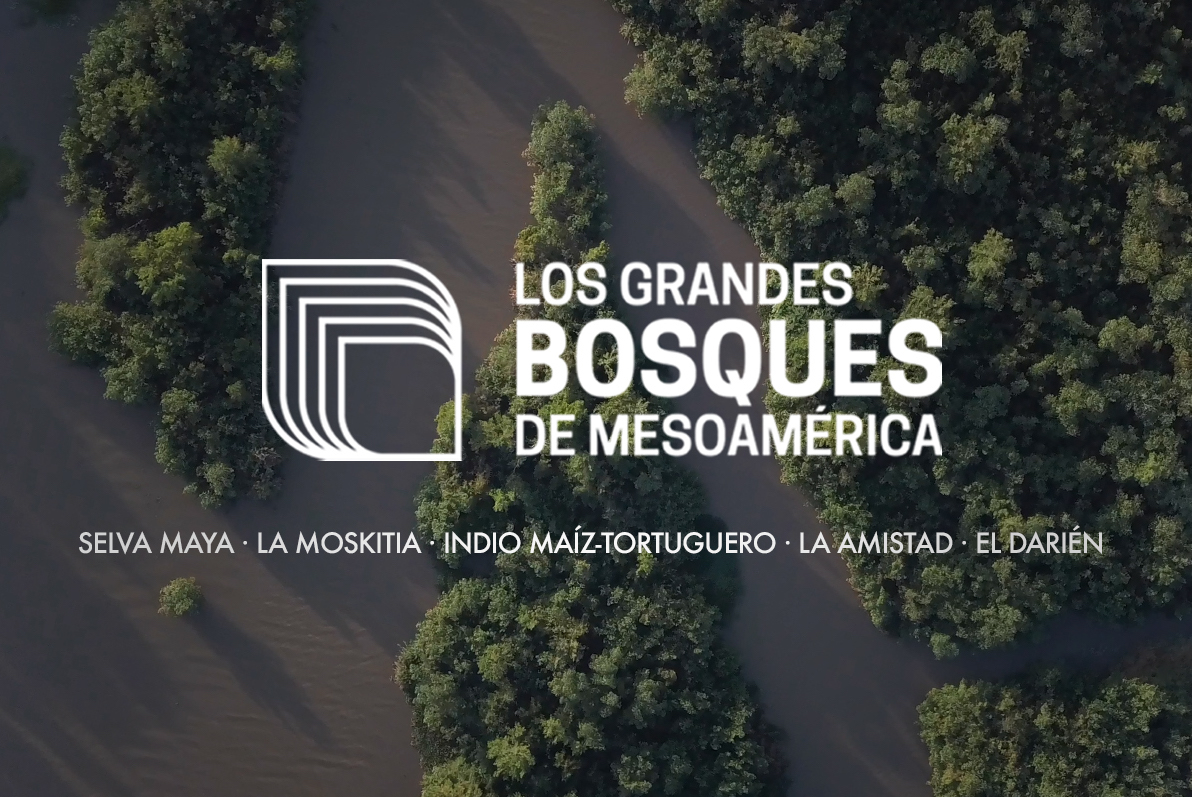

Newsletter #3 EU DeSIRA
February 2023
Descarga el boletín
I. Introduction
This newsletter covers the period of the last quarter of the year 2022 and its objective is to inform our community partners, indigenous associations, organizations, governments and the European Union community about the progress of the 5 Great Forest Alliance, within the framework of the EU DeSIRA project (Development of Smart Innovation through Research in Agriculture). The last section includes a summary of the progress of the Green Climate Fund (GCF) Readiness project.
During this quarter, the European Union announced the scaling up of the investment, which was announced at the COP27 held in Egypt, where representatives of all the project executors participated.
Likewise, the design of the Small Grants Program (SGP) was finalized, which will begin to be implemented in February 2023, with priority to the La Amistad and El Darien Forests.
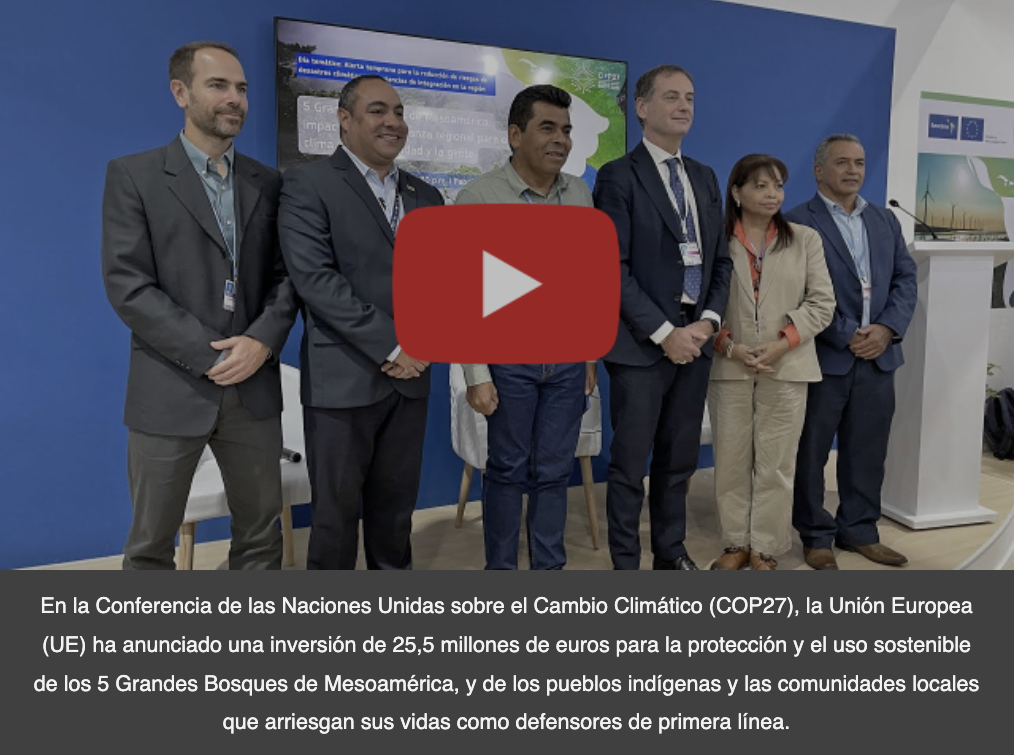

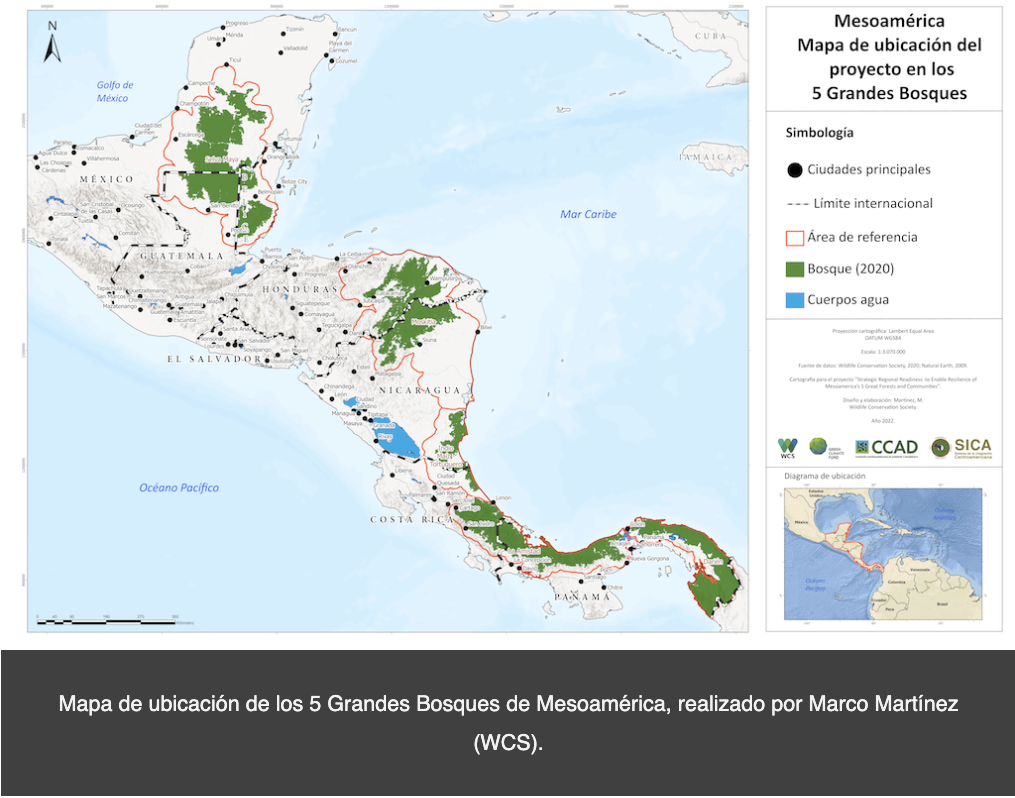
II. Integration of progress by Forest and its strategic lines of action
The EU DeSIRA project supported by the European Union leads the Conservation and Sustainable Development in the 5 Great Forests of Mesoamerica whose goals for 2030 are:
- 10 million hectares of protected forest
- 500,000 ha of recovered forest
- 0 species extinctions
- 0 illegal cattle ranching in the 5 forests
- Improved human well-being, especially for indigenous peoples and forest communities.
The following are the main advances in each of the forests:

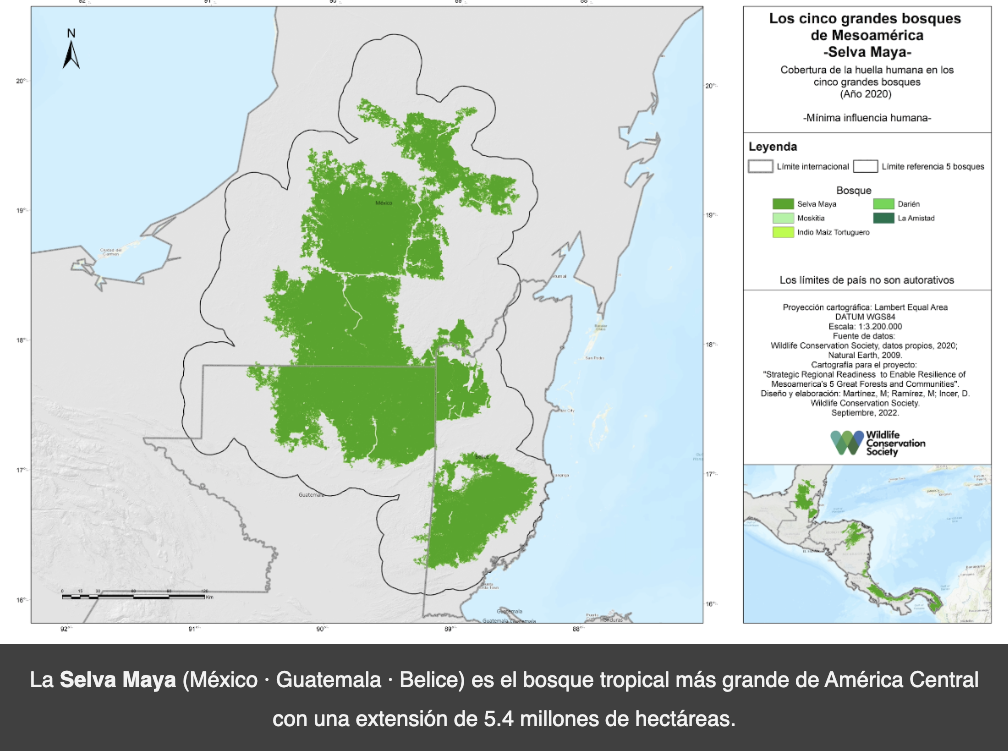
GUATEMALA
In the Mayan Forest of Guatemala, the approval of the first four Forestry Incentive Programs for Small Landholders of Forest or Agroforestry Vocation (PINPEP) of the National Forest Institute (INAB) stands out. This is a historic achievement, since for the first time the contribution of community members to forest conservation in Laguna del Tigre National Park (PNLT) is being recognized and encouraged.
In San Miguel La Palotada, 21 inter-institutional and community meetings were held to manage the process to regularize in the medium term the permanence of the settlers within the entire San Miguel Management Unit (7,039 ha).
A meeting was held between WCS Mesoamerica and the Caribbean, CIAT and livestock experts from the northern region of Guatemala to understand the livestock dynamics and cattle trafficking from Central America to Mexico. Epidemiological monitoring continued at the Dos Aguadas crossing to determine the prevalence of bovine brucellosis.
The first apiary school with 25 hives (Apis mellifera) was approved and established in the community of Paso Caballos in the PNLT.
In the La Colorada/El Molino Management Unit, in coordination with the community organization Sociedad Civil Selva Maya del Norte, we began the first phase of planting trees of five species on 48 hectares.
The process of natural regeneration continues in areas occupied by illegal cattle ranching. The nesting of native birds and the height of pioneer species can be observed in record photos.
Finally, in the area of protection, we conducted training and monitoring with drones in the community of Uaxactún.
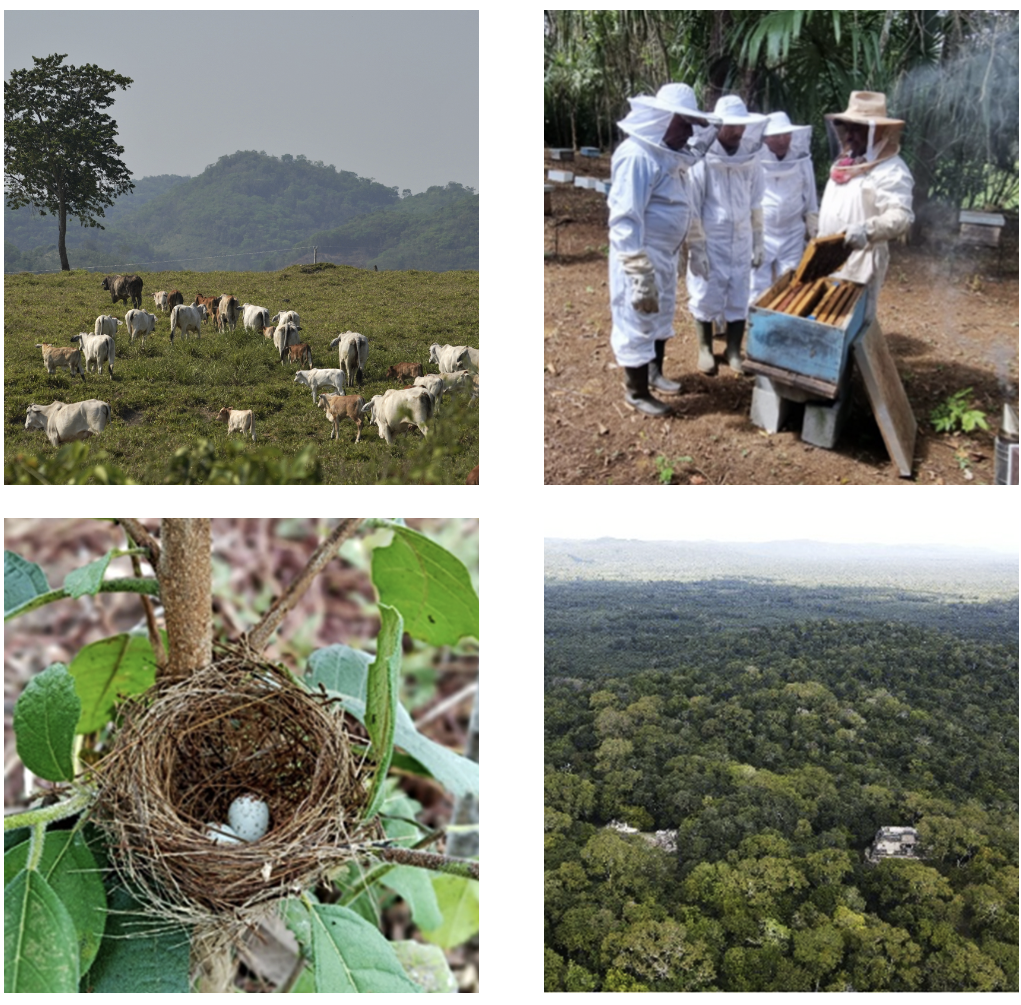
BELICE
In the Maya Forest of Belize, the greatest progress was made in protecting the property and landscape of the Maya Forest Corridor, where 82 patrols were carried out in the last six months, covering a distance of 2192 km. Four critical points of concentration of major threats and 14 of illegal activities and threats were identified, which will allow planning to improve patrolling.
We supported fire management training, where WCS Belize staff, together with Maya Forest Corridor (MFC) Coalition Partners participated in 3 training on prescribed burn planning; forest fire incident command and fire effects monitoring. These activities are part of the "Integrated Fire Management Plan for CFM". WCS also developed a Forest Landscape Restoration framework for JFM guided by the "National Landscape Restoration Strategy for Belize: 2022-2030" and the Belize National Agroforestry Policy 2020.
In relation to livelihoods, the community learning exchange between four Belize River Valley communities to the Maya-Mayan Golden Landscape (MGL) stands out. The MGL includes the Bladen Nature Reserve, the Maya Mountain North Forest Reserve, a multiple-use site for protected area innovation, and the Golden Stream Corridor Reserve, all managed by Ya'axché Conservation Trust.
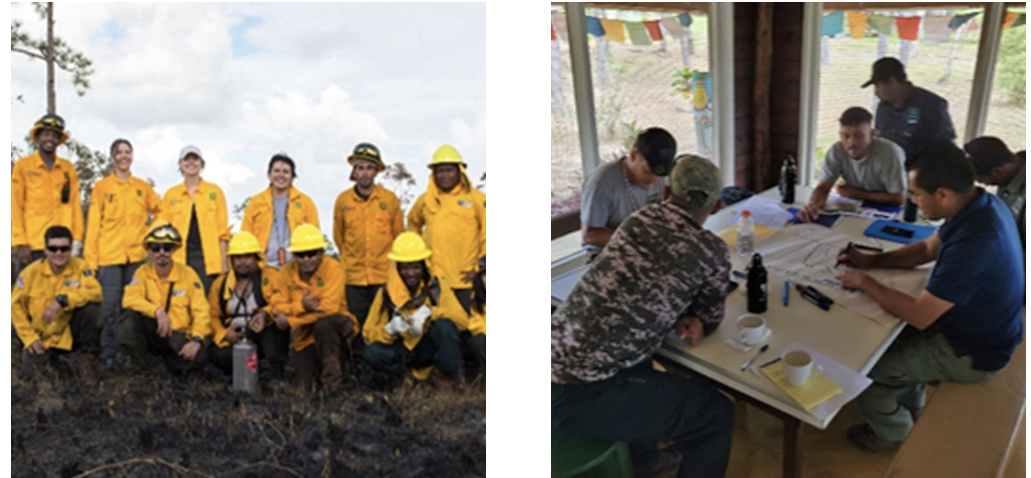

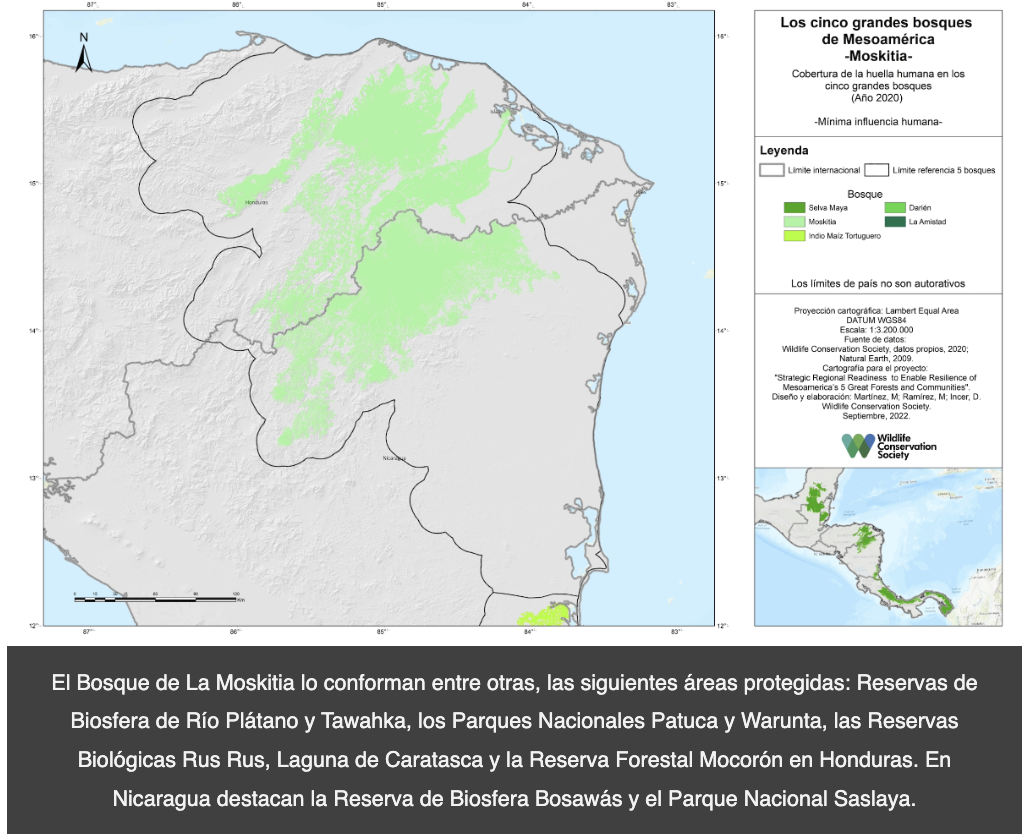
NICARAGUA
In La Moskitia Nicaragüense, field data collection and livelihood strategies of 210 producers participating in alternative production initiatives to livestock, cocoa agroforestry systems and in communities in the indigenous territories of Río Coco and Bocay were completed. Preliminary analysis indicates that cocoa, domestic animals (pigs and chickens) and basic grains (beans and rice) are part of the food security of the communities, and that they also have a good local market.
The 14,000 cocoa plants were delivered to 184 beneficiaries and will have a direct impact on 214 hectares of production systems in 30 communities. It is recalled that 6,000 seedlings that were affected by Hurricane Julia were replanted and recovered. Some of the communities and territories benefited are: Mayangna Sauni Bu and Rio Coco Abajo and Arriba, Amak, Samaska, Nawawas, Pamkawas, Tuburús, Kudahwas, Ahsawas, Brikputwás, Wiwinak, Walakitang, Inipuwás, Pansik, Aniwas, Auhika, Wayawás, Kiwayang, La Esperanza, Amarrahna, Shiminka, Yakalpananí, Paraíso, Laukuwas, Pueblo Nuevo, Piu, Sani Bila and Ulwasking.
In the area of patrolling, training was provided in Spatial Monitoring and Reporting Tool (SMART) and GIS for members of the technical teams of the Indigenous Territorial Governments (GTIs) and personnel representing the central government.
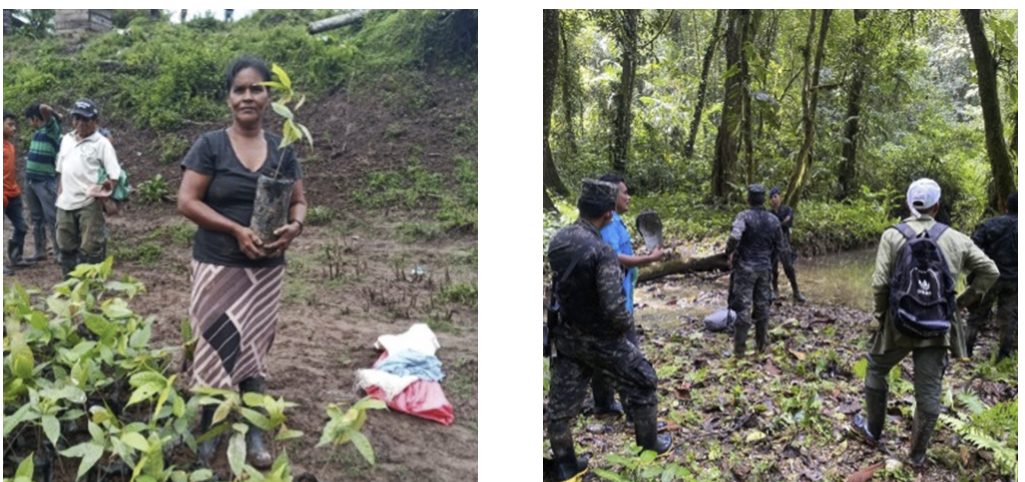
HONDURAS
At La Moskitia Hondureña, progress has been made in agroforestry systems, nurseries, grafting and transfer to the final field. Grafting is with cocoa rootstocks with buds from clones certified by the Honduran Foundation for Agricultural Research (FHIA). The three clones grafted are of high quality, guaranteeing high compatibility, productivity, and disease resistance. The Asociación de Productores de Cacao de Olancho (APROSACAO) collaborated in the grafting process and provided training for agricultural technicians.
In summary, this quarter we worked with 30 producers, with 5,220 corms of musaceae, 696 cocoa seedlings for an estimated 14.6 hectares. Likewise, 1,392 seedlings have been grafted in the community of Pimienta, 1,328 in the community of Tukrum and in Kurhpa more than 3,525 rootstocks are in the process of being grafted.
The Bioversity - CIAT Alliance began the process of analyzing livelihoods from the point of view of added value and market. Interviews are conducted through virtual, face-to-face and group means. The work is concentrated in the Bakinasta area, communities of Puerto Lempira, Wampusirpi and Pimienta.
Finally, in the area of conservation consolidation, SMART patrols continue to be carried out in the Diunat and Bakinasta territories with indigenous resource guards, but also with Territorial Council Directors in the company of members of the Armed Forces. By land, more than 634 km were covered, with 23 resource guards and a total of 102 patrol days. By sea, 294 km, 12 resource guards and 21 days.
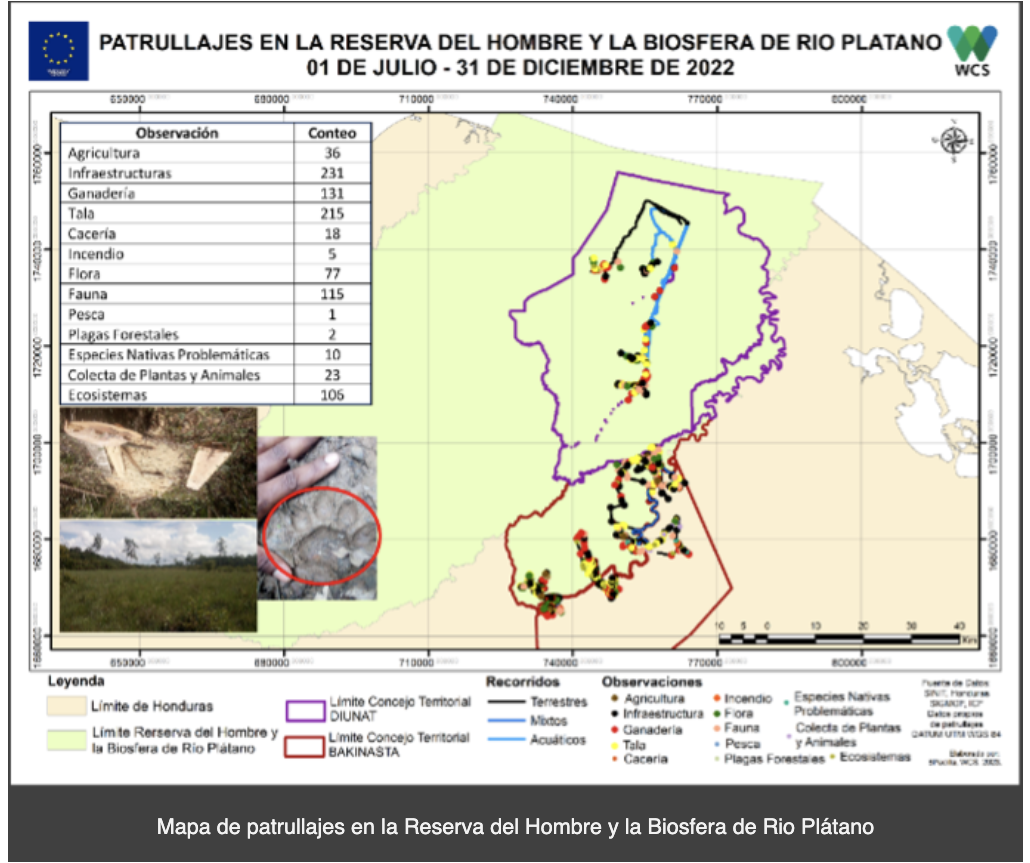

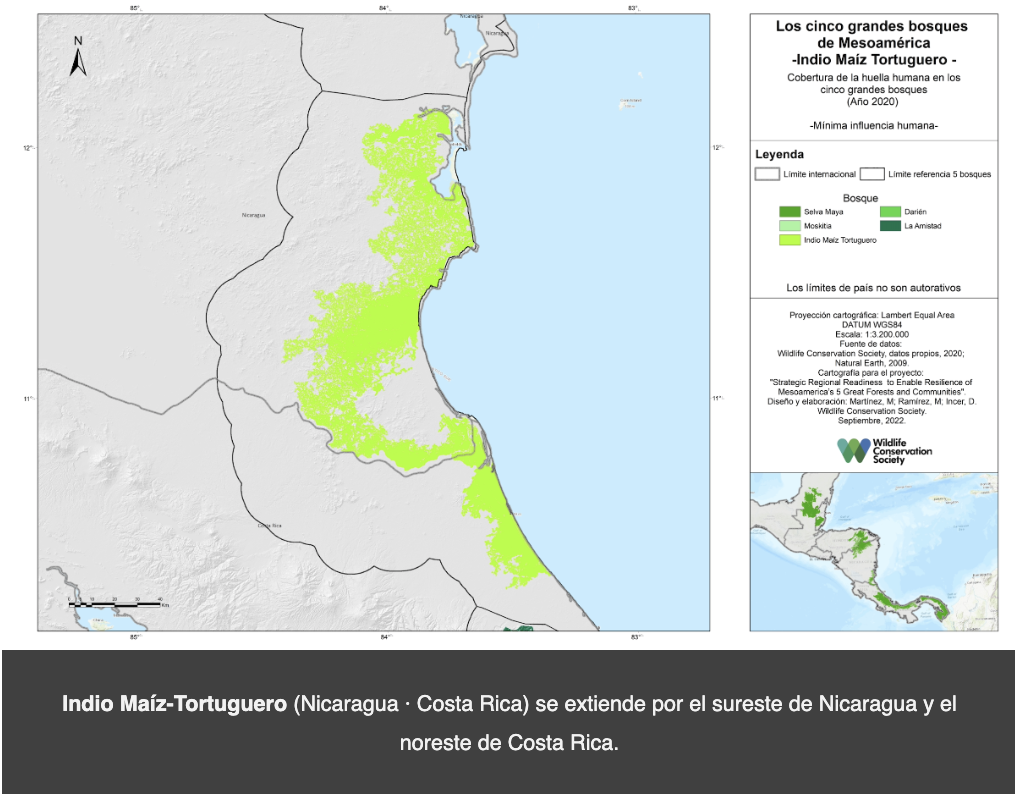
INDIO MAÍZ-TORTUGUERO
In this forest, 11 community patrols were conducted at the end of 2022 with the support of Re:wild within the Rama Kriol Territory (Indio Maiz Biological Reserve). More than 203.36 kilometers were covered between aquatic, terrestrial and mixed patrols using the SMART tool. Twenty-four observations related to human activity were recorded (indirect observation of people n=1, camps n=1, timber n=1, burns and fires n=3, infrastructure and roads n=1, housing n=1, plantations and orchards n=5, mining n=1, clearing n=8, agricultural roads n=2).
Ten indirect wildlife observations were also recorded (Tayassu pecari n=3, Tapirus bairdii n=2, Panthera onca n=4, Leopardus pardalis n=1). In addition, a Rama technician has been supported with the SMART application and has centralized the management and monitoring of the data. This person has helped in the coordination of all activities related to Indio Maíz.

IV. Small Grants Programme (SGP) in La Amistad and El Darién
The Small Grants Programme (SGP) will begin its process in February 2023, with priority investments in La Amistad and El Darien Forests. Its thematic focus is on:
- Supporting climate and forest resilient rural agriculture.
- Restore areas recovered from illegal cattle ranching.
- Improving forest protection, management, governance and monitoring in state protected areas and on lands managed by indigenous and/or local communities.
The main activities in La Amistad focused on continuing the process of socializing the SGP with indigenous communities and local associations and meetings with Re:wild and the Mesoamerican Alliance of Peoples and Forests (AMPB) for analysis and support.
In recent months the main communities of La Amistad in the Pacific region were visited and approached: Kabek and Paraíso Quetzal Project, Paraíso Quetzal Hotel, San Jerónimo, Community Security and Environmental Protection Association (SECUPAC), Ena Tourism Association (ATURENA), Proyecto Bosque para nacer Agua / Diwo Ambiental, Asociación de Turismo Eco-cultural Indígena So Cagru y Asociación de Desarrollo Integral Indígena Boruca Ridge to Reef Landscape / Osa Conservation and finally the La Amistad Producers Association (AsoProLA).
In early January 2023, a face-to-face meeting was held in Kekoldí, La Amistad Caribe with representatives of Re:wild, WCS, AMPB, the National System of Conservation Areas (SINAC), the Network of Indigenous Bribri and Cabécar Peoples (RIBCA), the Association of Indigenous Women Kábata Könana and the Coordinating Committee of Women Territorial Leaders of Mesoamerica (CMLT) and the Youth Movement of the Mesoamerican Alliance of Peoples and Forests (Alianza Mesoamericana de Pueblos y Bosques). The objective was to socialize the SGP and get to know some of the community territories, their directors and women leaders.
In El Darién, meetings were held with representatives of the Ministry of the Environment, the Mamoní Valley Reserve, forest rangers from the Emberá, Guna and Mamoní groups, and foundations such as Geoversity, Ancón, Río Chagres and the Jardines en Balsas del Darién project. In Panama City, SGP socialization meetings were held with the Boards of Directors of the Guna and Emberá Comarcas.
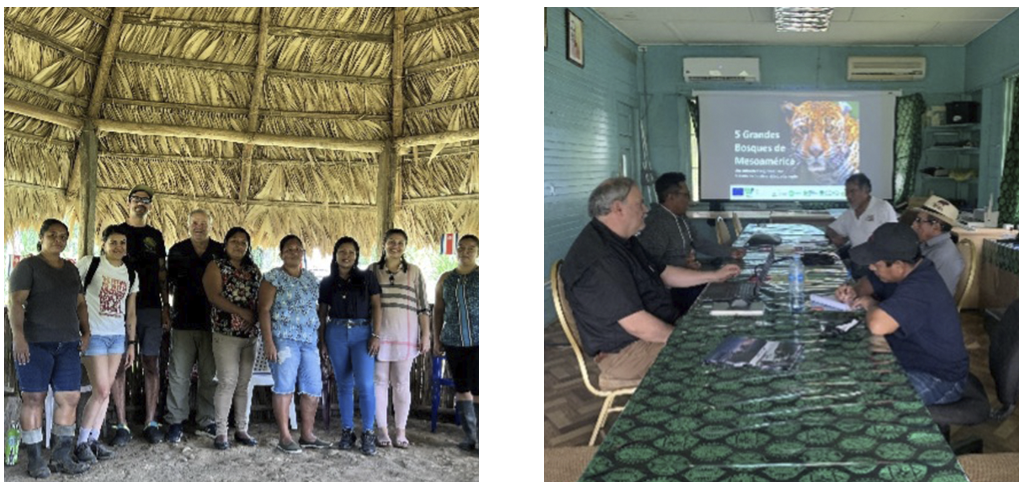
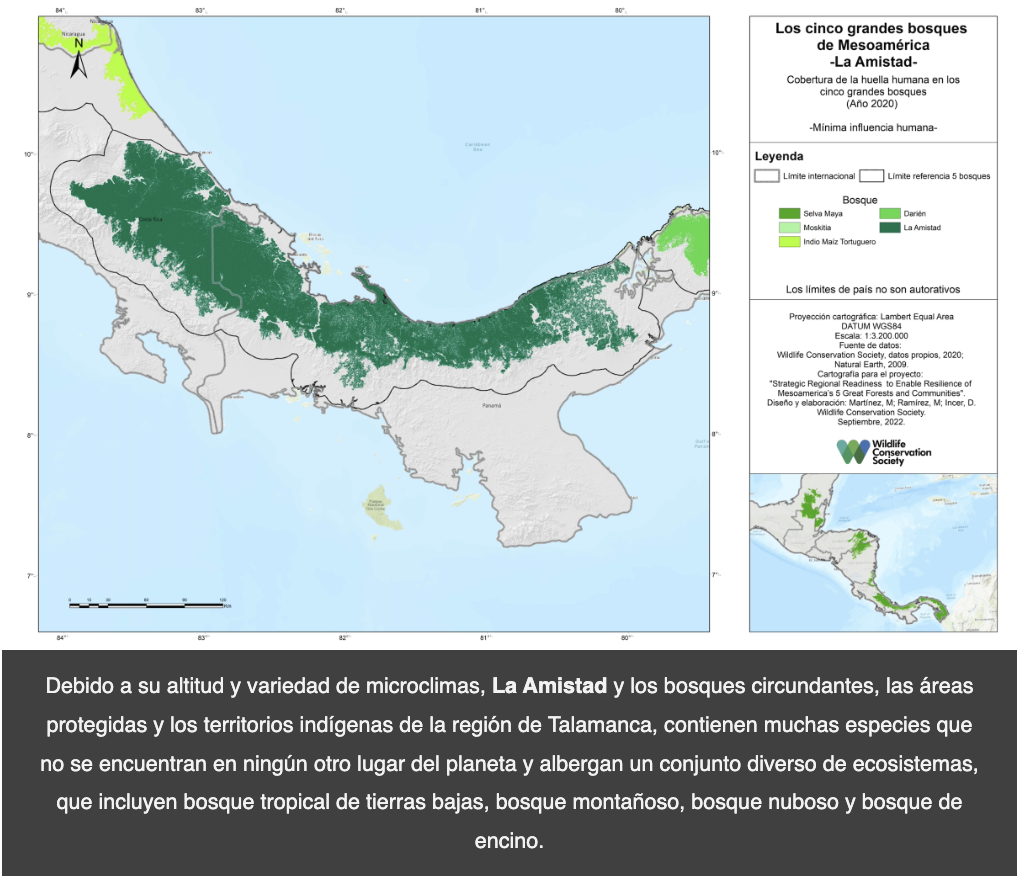
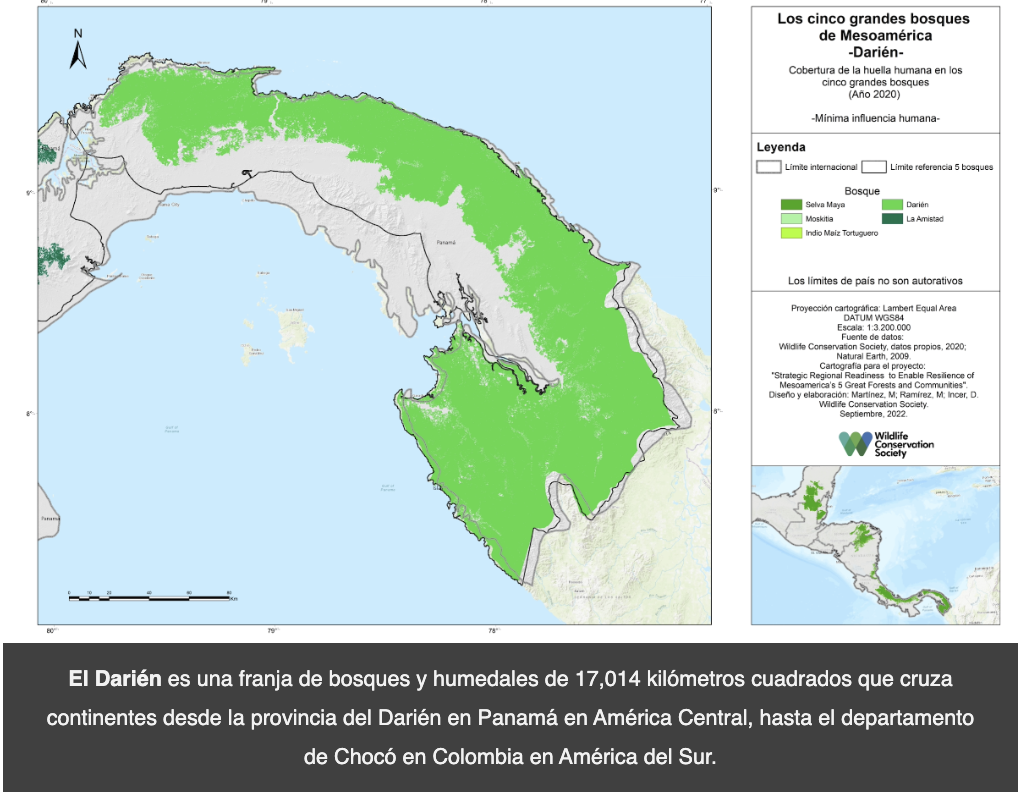
V. Progress in updating the Human Footprint in the 5 Great Forests of Mesoamerica
Under the framework of the Readiness Project supported by the Green Climate Fund (GCF), the main advances detailed below were made towards strategic regional readiness to enable the resilience of the 5 Great Forests and communities of Mesoamerica.
1. Update of Protected Area information in the 5 Great Forests
During the last quarter, under the leadership of the University for International Cooperation (UCI) and with the support of CCAD authorities, the WCS team and consultants, a workshop was held in Costa Rica on control in protected areas, patrolling and updating protocols with emphasis on the 5 Great Forests. This process made it possible to establish the threat situation and general control and surveillance needs of the protected areas.
2. Information generated and databases
The following products were completed in conjunction with specialists in geographic information systems, communication and administration:
- A series of updated maps and shapefiles of the 5 Great Forests were developed that include, among other aspects: Forest condition; historical analysis of forest loss in the region, the location of indigenous populations and the main infrastructures around these territories.
- A database was established with all available information on forests that has been compiled during 2021 and 2022.
- WCS is proposing to establish a system that allows public access to these documents and in particular, access by the groups involved in the initiative.
3. Creation of ArcGIS Story Maps, gender and equity approach and other communication mechanisms
The lack of access to information is one of the factors that reduce the social resilience of rural communities and indigenous peoples in the 5 Great Forests, which is why one of the main achievements that can be identified and that were completed this past quarter include:
- The StoryMaps of the 5 Great Forests of Mesoamerica in collaboration with the Universidad del Valle de Guatemala (UVG). This tool allows the visualization of interactive maps and multimedia content. It is still in the process of authorization and eventually, a recipient and administrator will have to be established.
- The review and incorporation of the gender and equity approach in all products generated.
- Updating the website and news portal in English and Spanish within the framework of the Green Climate Fund (GCF) and WCS.
- The design of a logo is in its final phase and awaiting approval.
- A communication strategy was completed, including a documentary record in photo and video, covering 4 forests, 40 interviews and 10 videos, which is expected to be published by the end of March 2023.
VI. Situation analysis and next steps
Activities during this quarter were carried out as planned. Of particular note was the scaling up of investment through the Mesoamerican Great 5 Forests Alliance at COP27 in Egypt. WCS, AMPB, CCAD, Re:wild and EU DeSIRA partners participated in the event, as well as in other important meetings for the initiative.
The main goals for the next quarter are the awarding of the first investments under the EU DeSIRA Small Grants Programme model.
A visit to the Central American Commission on Environment and Development (CCAD) is expected to take place, in order to jointly plan the main activities to be executed, in accordance with the signing of the contract already executed.
Also significant is the progress made in the synthesis and analysis of the status of the 5 Large Forests under the GCF project, which serves as an input to promote greater coordination of efforts and impact in the 5 Large Forests. In the next semester, the publication of key information is expected to continue in order to ensure access by all stakeholders, in addition to the development of a regional coordination and dialogue process.

Descarga el boletín
